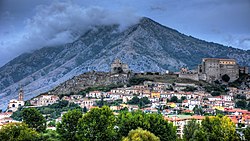Montesarchio
| Montesarchio | ||
|---|---|---|
| Comune | ||
| Città di Montesarchio | ||

View of the hamlet Latonuovo with the Tower and the Castle, and Mount Taburno on the background
|
||
|
||
| Location of Montesarchio in Italy | ||
| Coordinates: 41°3′40″N 14°38′0″E / 41.06111°N 14.63333°E | ||
| Country | Italy | |
| Region | Campania | |
| Province / Metropolitan city | Benevento (BN) | |
| Frazioni | Varoni, Cirignano, Tufara Valle | |
| Government | ||
| • Mayor | Francesco Damiano | |
| Area | ||
| • Total | 26.3 km2 (10.2 sq mi) | |
| Elevation | 300 m (1,000 ft) | |
| Population (31 August 2015) | ||
| • Total | 13,518 | |
| • Density | 510/km2 (1,300/sq mi) | |
| Demonym(s) | Montesarchiesi | |
| Time zone | CET (UTC+1) | |
| • Summer (DST) | CEST (UTC+2) | |
| Postal code | 82016 | |
| Dialing code | 0824 | |
| Patron saint | Saint Nicholas | |
| Saint day | 6 December | |
| Website | Official website | |
Montesarchio (Latin: Caudium; Greek: Καύδιον) is a comune in the Province of Benevento, Campania, southern Italy. It is located 18 kilometres (11 miles) south-east of Benevento in the Valle Caudina at the foot of Monte Taburno. The commune was granted the official status of City (Città) by a presidential decree of 31 July 1977.
Montesarchio is the site of ancient Caudium, an ancient city of Apulia et Calabria, situated on the road from Beneventum (modern Benevento) to Capua. It seems probable that it was in early times a place of importance, and the capital or chief city of the tribe called the Caudini; but it bears only a secondary place in history. It is first mentioned during the Second Samnite War, 321 BCE, when the Samnite army under Gaius Pontius encamped there, previous to the great disaster of the Romans in the neighbouring pass known as the Caudine Forks; and again, a few years later, as the headquarters occupied by the Samnites, with a view of being at hand to watch the movements of the Campanians. The town of Caudium is not mentioned during the Second Punic War, though the tribe of the Caudini is repeatedly alluded to.
Niebuhr supposes the city to have been destroyed by the Romans, in revenge for their great defeat in its neighbourhood; but there is no evidence for this. It reappears at a later period as a small town situated on the Appian Way, and apparently deriving its chief importance from the transit of travellers: the same causes preserved it in existence down to the close of the Roman Empire. It received a colony of veterans; and it appears from Pliny, as well as from inscriptions, that it retained its municipal character, though deprived of a large portion of its territory in favor of the neighboring city of Beneventum. The period of its destruction is unknown: the name is still found in the 9th century, but it is uncertain whether the town still existed at that time.
...
Wikipedia


